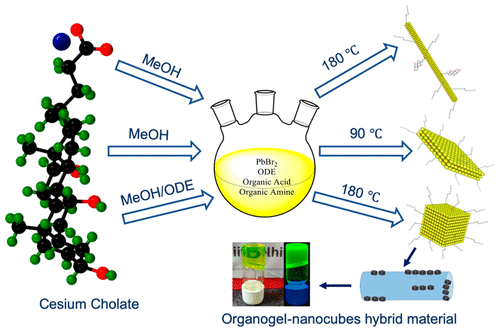当前位置:
X-MOL 学术
›
Chem. Mater.
›
论文详情
Our official English website, www.x-mol.net, welcomes your feedback! (Note: you will need to create a separate account there.)
Precursor-Mediated Synthesis of Shape-Controlled Colloidal CsPbBr3 Perovskite Nanocrystals and Their Nanofiber-Directed Self-Assembly
Chemistry of Materials ( IF 8.6 ) Pub Date : 2020-01-07 , DOI: 10.1021/acs.chemmater.9b03700 Arkajyoti Chakrabarty 1 , Samridhi Satija 1 , Upanshu Gangwar 1 , Sameer Sapra 1
Chemistry of Materials ( IF 8.6 ) Pub Date : 2020-01-07 , DOI: 10.1021/acs.chemmater.9b03700 Arkajyoti Chakrabarty 1 , Samridhi Satija 1 , Upanshu Gangwar 1 , Sameer Sapra 1
Affiliation

|
Shape control is often necessary to tune the optical and electronic properties of nanocrystals (NCs) and is mostly achieved through manipulation of surface ligands and processing conditions. Here we present a versatile synthesis of colloidal CsPbBr3 perovskite NCs of various shapes (nanorods, nanocubes, and nanoplatelets) from an inexpensive steroidal Cs precursor: cesium cholate (CsCh). Cesium cholate has several advantages over the most commonly used Cs precursor (cesium oleate or Cs2CO3 or CsOAc) such as low cost, nonhygroscopicity, and better reproducibility in the perovskite synthesis. Due to the solubility of this Cs precursor in polar solvents such as methanol, a miniscule polar environment is created during the nucleation and growth of the nanocrystals leading to the serendipitous formation of nanorods at 180 °C, whereas using a biphasic mixture of 1-octadecene and methanol, the morphology changes to nanocubes. By lowering the reaction temperature (90 °C), nanoplatelets with 8–9 monolayers thicknesses are formed. These colloidal NCs of a variety of shapes are strongly luminescent with a green emission having narrow emission line widths (16–17 nm) and high quantum yields (96% for nanocubes, 94% for nanoplatelets). Furthermore, hybrid materials of nanocubes and organogel of a dimeric bile acid-derived ester gelator are obtained through coassembly in which nanocubes arrange along nanofibers with stable, sharp, and bright green emission. This enables spatial ordering of nanocubes ranging from micrometer to centimeter scale in thin films, which is crucial for advanced optoelectronic applications. To date, there is no report in the literature on the anisotropic organization of perovskite CsPbBr3 nanocubes triggered by supramolecular coassembly involving organogel nanofibers.
中文翻译:

前体介导的形状控制的胶体CsPbBr 3钙钛矿纳米晶体的合成及其纳米纤维定向的自组装。
形状控制通常是调整纳米晶体(NCs)的光学和电子特性所必需的,并且大多是通过操纵表面配体和加工条件来实现的。在这里,我们介绍了一种廉价的甾体Cs前体:胆酸铯(CsCh),可以合成各种形状(纳米节,纳米立方体和纳米片状)的胶体CsPbBr 3钙钛矿型NC。与最常用的Cs前体(油酸铯或Cs 2 CO 3(例如CsOAc),例如低成本,非吸湿性和钙钛矿合成中更好的重现性。由于这种Cs前体在极性溶剂(例如甲醇)中的溶解性,因此在纳米晶体的成核和生长过程中会形成微小的极性环境,导致在180°C时偶然形成纳米棒,而使用1-十八碳烯的双相混合物和甲醇,形态变为纳米立方体。通过降低反应温度(90°C),可以形成单层厚度为8–9的纳米片。这些形状各异的胶体NC发出强烈的光,发出绿色的光,具有窄的发射线宽度(16-17 nm)和高的量子产率(纳米立方体为96%,纳米片为94%)。此外,通过共组装获得纳米立方体和二聚胆汁酸衍生的酯胶凝剂有机凝胶的杂化材料,其中纳米立方体沿着纳米纤维排列,并具有稳定,清晰和亮绿色的发射。这使得薄膜中纳米立方体的空间排序范围从微米到厘米,这对于先进的光电应用至关重要。迄今为止,关于钙钛矿CsPbBr的各向异性组织的文献尚无报道。由涉及有机凝胶纳米纤维的超分子共组装引发的3个纳米立方体。
更新日期:2020-01-07
中文翻译:

前体介导的形状控制的胶体CsPbBr 3钙钛矿纳米晶体的合成及其纳米纤维定向的自组装。
形状控制通常是调整纳米晶体(NCs)的光学和电子特性所必需的,并且大多是通过操纵表面配体和加工条件来实现的。在这里,我们介绍了一种廉价的甾体Cs前体:胆酸铯(CsCh),可以合成各种形状(纳米节,纳米立方体和纳米片状)的胶体CsPbBr 3钙钛矿型NC。与最常用的Cs前体(油酸铯或Cs 2 CO 3(例如CsOAc),例如低成本,非吸湿性和钙钛矿合成中更好的重现性。由于这种Cs前体在极性溶剂(例如甲醇)中的溶解性,因此在纳米晶体的成核和生长过程中会形成微小的极性环境,导致在180°C时偶然形成纳米棒,而使用1-十八碳烯的双相混合物和甲醇,形态变为纳米立方体。通过降低反应温度(90°C),可以形成单层厚度为8–9的纳米片。这些形状各异的胶体NC发出强烈的光,发出绿色的光,具有窄的发射线宽度(16-17 nm)和高的量子产率(纳米立方体为96%,纳米片为94%)。此外,通过共组装获得纳米立方体和二聚胆汁酸衍生的酯胶凝剂有机凝胶的杂化材料,其中纳米立方体沿着纳米纤维排列,并具有稳定,清晰和亮绿色的发射。这使得薄膜中纳米立方体的空间排序范围从微米到厘米,这对于先进的光电应用至关重要。迄今为止,关于钙钛矿CsPbBr的各向异性组织的文献尚无报道。由涉及有机凝胶纳米纤维的超分子共组装引发的3个纳米立方体。



























 京公网安备 11010802027423号
京公网安备 11010802027423号